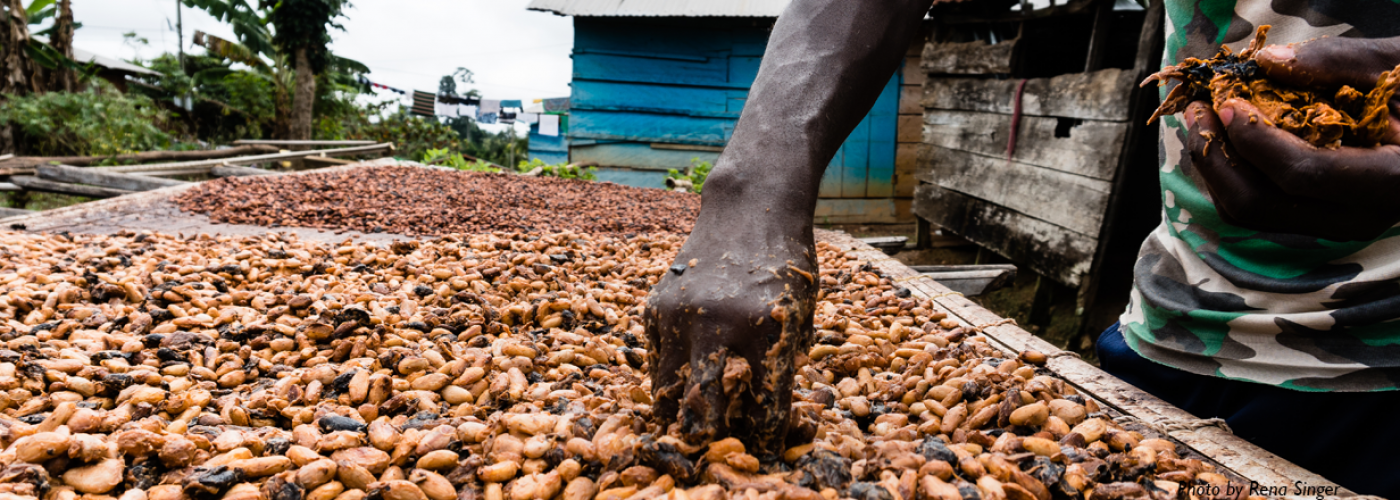The Business Case for Land Rights: You Asked, We Answered
Image

This Q&A blog was originally published on the LandLinks website.
USAID LandLinks hosted a webinar on “The Business Case for Land Rights: Private Sector Perspectives on Responsible Land-Based Investment” on November 2, 2017. Due to the high level of interest, there were more questions from the audience than we were able to answer. Our panelists, Jeff King (Hershey’s) and Olga Gormalova (ECOM Agroindustrial), took the time to answer some of the most interesting questions, which we share here.
Question: How do your approaches to land tenure affect women in cocoa communities — not only female-headed households but women providing labor?
JEFF: We would advocate that these land-right changes would apply equally to both men and women, as women’s empowerment is a key tenant of CocoaAction. Many of the income diversification opportunities we help bring to these communities are targeted towards women.
Question: What concerns are women in cocoa communities voicing related to land tenure?
OLGA: Women face even more constraints when it comes to land ownership, many work on either plots that belong to their husband or husband’s family — hence in instances when the husband dies, the family of the husband can take over the farm without any benefit being passed on to the wife. There are various community based organizations that encourage husbands to legally assign a plot to the wife — if adopted, this would improve women’s land ownership rights.
Question: Do you know how many cocoa farms in Ghana do not have proper land tenure?
JEFF: This is very hard to estimate, as we are still collecting the data across our supply chain on the different types of land ownership to truly know the breakdown between owners of land and other forms of tenure. However, as discussed in the pilot documents, the laws are not favorable towards anyone trying to secure new land and are complicated should someone wish to sell land to another person. Additionally, the tree tenure laws (that the farmer does not actually have ownership of timber on their farm) act as a disincentive for farmers to plant shade trees which can help mitigate climate change, improves the yield of cocoa, and could act as a future revenue source for farmer.
OLGA: One resource that might address this question is the USAID Assessment of Land Tenure-Related Constraints to Cocoa Productivity in Ghana, which notes on page five that, “Land tenure in Ghana is governed by a pluralistic legal system, in which customary and statutory tenure systems overlap. Approximately 20 percent of land in Ghana is owned by the State, and governed by statutory law. The rest, approximately 80 percent of all land, is governed through customary tenure arrangements and vested in chiefs or other customary authorities. The vast majority of cocoa is farmed on customary land.” This is not to say that all customary land arrangements are not clear or undocumented, but a large portion of these arrangements is oral — hence insecure.
Question: I am here with a group of students. We are finding it a bit counter-intuitive that these businesses that rely on a steady supply of cocoa are encouraging crop and income diversification. Could this be a bit more explored or explained?
JEFF: The ultimate objective is to ensure cocoa farming as a prosperous and long-term viable business for the farmer, thereby securing the future of cocoa — of which you rightly indicate we all want to see a steady supply. Diversification provides a more stable business for the cocoa farmers in three primary ways:
- Steadier stream of income. Cocoa farmers get two harvests per year, one large and one small. This large period of time between harvests can create economic strain on the family. By having other sources of income, this revenue cycle is smoother between harvests.
- Mitigate the natural price movement in crop prices. All crops have natural movement in prices, this is no different for West African cocoa farming vs. US corn or dairy farmers. By having multiple sources of income, farmers are not over-reliant on a single crop and will be less impacted by these natural price fluctuations.
- Greater participation by women in generating household income. Many of these income diversification opportunities are run by women. This increases the earning potential of the farming household but also acts as a strong empowerment vehicle for the women in these communities.
Question: What were the insecurity issues, and what are other lucrative income generating opportunities for farmers in this area of Ghana?
OLGA: The main issue is when the farmer knows that when he cuts down his aged cocoa farm, he will lose the right to that farm, or will have to renegotiate the arrangement, so many of the farmers opt not to cut the farm (40 percent of cocoa farms in Ghana are aged). There are opportunities for farmers in food crops like cabbage, tomatoes, rice, and maize, but these are perishable crops and farmers need to look for markets (unlike cocoa, which has a secure market; if you have cocoa beans then anyone can convert it into cash at any time).
Question: Could you please elaborate on what kind of adaptation/resilience plans Hershey’s is working on for cocoa farming and farmers in terms of changing climate?
JEFF: Hershey’s is working with the World Cocoa Foundation on the Climate Smart Cocoa program, which is a partnership between WCF members, USAID, and the governments of Cote d’Ivoire and Ghana, identifying and enabling methods to encourage farmers to utilize climate smart agricultural practices including zero deforestation. Additionally, Hershey’s is a signatory of the Cocoa & Forest Initiative, under which we are developing our company plans on how to support ensuring zero deforestation in cocoa including reforestation programs.
Question: What led to the shift from managing supply chains to managing farms and farmers? This presumably costs you more. Are the benefits greater than the costs? Have you measured costs and benefits?
OLGA: ECOM has developed its new service of farm management and rehabilitation out of frustration that farmers were not adopting recommended practices we trained them on. So when we are questioned about impact (by our chocolate maker clients), it is very hard to show that adoption happens at farmer and farm level. The reasons why smallholders are not investing sufficiently in their existing plantations are varied and complex. The adoption issue is more complex than just lack of knowledge. One of the other key factors is limited ability of many smallholders to access credit (also due to lack of any land documentation). Chocolate makers are not traditionally used to financing these types of interventions, as they could instead be opportunities for businesses like micro-finance or agro-inputs dealers. Existing businesses do not seem to reach all the farmers, and since ECOM invested a long time in establishing a good primary procurement network, we wanted to use this as an opportunity. Instead of just buying cocoa through the same channel, we developed various services for farmers.
At the beginning costs outweigh benefits, but over time if the business opportunities of working closer at the farm and farmer level is well developed — plus we tap into wealth of our knowledge — we believe our business will also be more sustainable and diversified.


